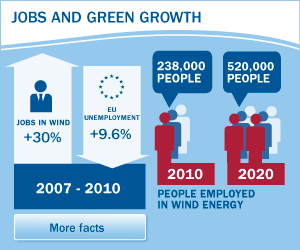Wind power, capacity, watts and kilowatt hours – how is it all connected?
 Complicated things sometimes can be explained in only a few words – check out EWEA’s FAQs to find the answers to your wind questions you were always looking for.
Complicated things sometimes can be explained in only a few words – check out EWEA’s FAQs to find the answers to your wind questions you were always looking for.
When talking about wind turbines and their capacity – that is, their ability to generate electricity — the word megawatt is used all the time. Capacity is measured in watts which is a very small unit, so people talk instead about kilowatts (1 kW = 1,000 watts), megawatts (1 MW = 1 million watts), and gigawatt (1 GW = 1 billion watts) when they want to describe the capacity of generating units like wind turbines.
The electricity production and consumption, on the other hand, is measured in kilowatt hours (kWh). A kilowatt hour means one kilowatt (1,000 watts) of electricity produced or consumed for one hour. That means one 50-watt light bulb left on for 20 hours consumes one kilowatt-hour of electricity (50 watts x 20 hours = 1,000 watt-hours = 1 kilowatt hour).
So how much electricity can a wind turbine produce? That depends on the turbine’s size and the wind speed. Today’s wind turbines have a capacity between 250 watts and 7 MW. The average turbine – with a capacity of 2.5-3 MW – can produce more than 6 million kWh in a year – enough to supply 1,500 average EU households with electricity.
The wind turbines in Europe installed by the end of 2009 are, in a normal wind year, able to provide 4.8% of the EU’s electricity demand. We at EWEA expect that in 2020, wind power will be able to supply 14-18% of that demand.
Do you want to find out how the turbine actually produces electricity, what the grid is and who runs it?
You can find answers to those and many more questions around wind power in EWEA’s FAQ section.






